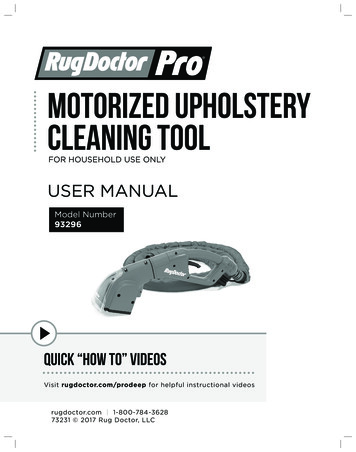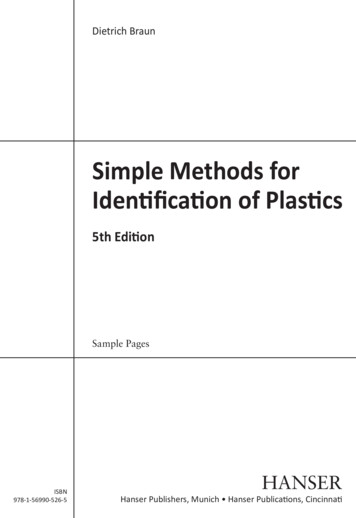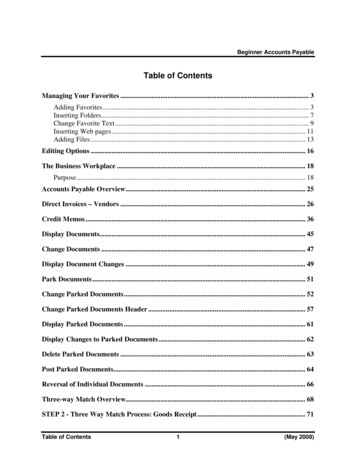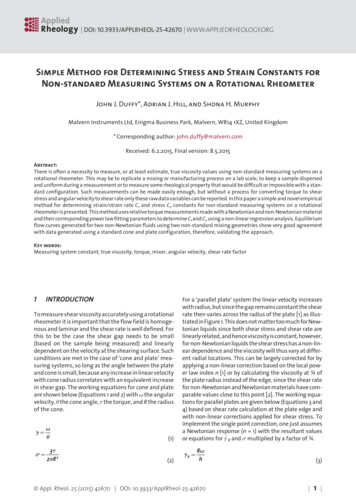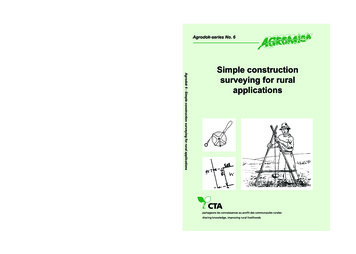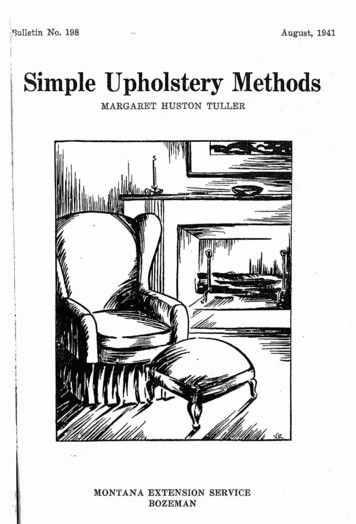
Transcription
i.'3ulletin No. 198August, 1941iI".[Simple Upholstery MethodsMARGARET HUSTON TULLER"I!i, IiIIiMON'l'ANA EXTENSION SERVICEBOZEMAN
TABLE OF CONTENTSIntroduction3Upholstering a Footstocl with SpringsTools Required for UpholsteringMaterials Required for UpholsteringSteps in UpholsteringPlacing the WebbingSetting and Fastening the SpringsTying the SpringsCovering the SpringsArranging the PaddingCovering the PaddingPutting on the Outside CoverAttaching the Lining344889101213131416Upholstering a Footstool Without Springs16Finishing Footstool Legs and Frame17Reconditioning Upholstered FurnitureComplete ReupholsteryRenewing WebbingReplacing Metal SupportsRetying SpringsRepairing Enclosed Spring UnitsReplacing Worn Outside Upholstery Covering1717 .1717171818SlJecial Reupholstering Problems.18Montana Extension Service in Agriculture and Rome Economics, J. C. Taylor director.Montana State College and Uniterl States Depal,tment of AgriCUlture cooperating.Distributed in ful.'therance of the Acts of Congress, May 8 and June 30, 1914.5M"".8'41
Simple Upholstery MethodsByMargaret Huston TullerHome Management SpecialistAlmost every home has at least one piece of upholstered furniture whichis neither comfortable nor presentable because of the need of upholsteryl·epairs. Worn coverings, sagging webbing, or "broken springs" have noplace in a well furnished home and can be corrected easily with a knowledgeof simple upholstery methods.The pl'ofessional upholsterer possessing unusual ability can demand ahigh price for his work, not because upholstery supplies are expensive butrather because hours of hand labor are put into the task of upholstering.The craft is not too difficult for the average individual to master.As inany other form of craftwork, the best results in upholstering will be obtained. by that person who chooses good materials, practices proper methods, andexel'cises the greatest care in workmanship.Upholstering a Footstool With SpringsAll the fundamental steps in upholstering any piece of furniture, with aframe deep enough for springs, are included in the making of an upholsteredfootstool with springs.upholstery principles,The footstool offel'S a splendid means of learningIt is small enough to be transported easily to ademonstration meeting, simple enough in -construction to be completed in aclay's time, inexpensive, and a welcome addition to the comfort of the home,
MONTANA EXTENSION SERVICE4'rools Required for UpholsteringStrong ShearsHammerTack PullerLarge-eyed Darning Needle,Mattress Needle, or StraightUpholstery Needle.Curved Upholstery NeedleFig. 1PliersWebbing Stretcher. The webbing stretcher may be made from a pieceof wood*" x3 Ih"X7", prefel'ably with the sides of the block curved inslightly to make it easy to grasp in the hand.Five or six 8-penny nails aredriven into one end of the block, the heads are cut off, and the ends of thenails are filed to make sharp teeth about % inch long. The other end of the tl'etcheris covered with rough leather, felt, or old velvet to prevent thestretcher from slipping and to keep it from marring the side of the frame,in case the wood is to be finished.Materials Required for UpholsteringFootstool Frame. The outside measurements of the frame should be 18"long, 12/1 wide, and 3" deep.Theframe may be made of white pineBlumber, 1%" thick, to hold the larg'eAnumber of tacks which will be driveninto the edges of the frame and toprovide adequate support for the foot·stool legs.The inside corners of theframe should be reinforced with smallblocks of wood not more than 1 inc',hFig. 2on a liide (Fig. 2 A), or with metal cornel' plates (Fig. 2 B).
SIMPLE UPHOLSTERY METHODS5Legs. Turned legs, 6 to 8 inches in height, may be pl'ocured fromcompanies dealing in upholstery materials or may be made locally, Theygive a professional appearance to the finished footstool. As they are gluedand screwed in place when the stool is ready for the outside cover, theiruse makes easier the handling of the frame during the process of upholstering. Square legs, tapered slightly toward the bottom and also 6 -to 8inches high, may be built into the frame, a continuation of the inside portionof each leg extending into the corner and taking the place of the frame reinforcement mentioned in the paragraph on the footstool frame.Screws. Eight screws at least :lh inch longer than the holes in thelegs are needed for attaching legs to frame.Taeks. Upholsterer's tacks in the follewing sizes are used:3 ounce (small for muslin and for outside cover);8 ounce (medium for webbing and burlap);12 ounce (large for spring twine);Gimp tacks or large-headed finishing tacks.'Vebbing. Two and one-fourth yards of 3 1h-inch webbing are requiredfor one footstool. The quality of the webbing selected affects greatly thedurability of the finished product. Webbing made of good material andrlosely woven will support the weight to which it is subjected. Poor qualitywebbing (made of jute, loosely woven, and sized to give the appearance ofhetter quality) win be a bad investment both from the standpoint of moneyand of time spent on the upholstering job.Springs Six strong springs, the same size top and bottom, are neededfor the footstool. Springs should be twice the heig'ht of the box in whichthey are to be used, provided the springs are sufficiently strong. Weakersprings should be taller or should be used double. New springs of strongmaterial may be procured at very small cost from upholstery dealers. Oldautomobile seats may yield springs which will serve the purpose very well.Care should be taken to match these springs for size and to stretch themback into shape if any of the coils have been mashed down.A good test for a spring is to stand it on a flat surface and press downupon it with the palm of the hand. If the two end -coils do not come together,if the coils do not bend sidewise, and if the spI'ing pushes strongly againstthe hand as the pl'essure is released, that spring will wear well in the upholstered article,
MONTANA EXTENSION SERVICE6Twine.Two kinds of twine are needed for upholstering:Flax mattress twine (a medium weight twine of great strength)for sewing springs and padding;Italian flax twine (heavy weight, strong, smooth twine) for tyingthe springs. The greatest wear in a piece of upholsteredfurniture comes on the spring twine, as it is subjected to stl'ainand to rubbing against the wires every time the piece offurniture is used. It is therefore most advisable that verystrong spring twine be procured. For the sake of the upholsterer's hands, spring twine should be smooth.Covering for Springs. The springs should be covered with closely wovenburlap, either new material bought by the yard or a burlap bag' in goodcondition. A piece 24" x 30 11 is the correct size for the footstool.Padding. Two layers of padding are used over the spring covering:(1)For the :first layer one pound of coarse padding is required.(a) Curled horsehair is best for the first layer but it is expensive. Often curled hair may be obtained from oldautomobile seats, in which case it should be cleaned. If thehair is in good condition, it may be cleaned by beating outthe dust and sterilizing in a 300 0 oven for one heul'; ifquite dusty and dirty, the hair should be packed veryloosely in a light weight muslin bag, washed in mild soapsuds, rinsed well, and hung in the air to dry.(b) The next best material is moss.(c) Least desirable of the acceptable materials is tow.(d) Excelsior should never be used for padding as it matswithin a short time.(2)For the second layer of padding a gcod grade of upholsterer'scotton is best. Common cotton wadding or batting may be usedwith fair success. One-half sheet of cotton wadding or battingwill be required for one footsteol.
SIMPLE UPHOLSTERY METHODS7Covering for Padding. Heavy unbleached muslin, salt sack of fh'mquality, or piece of a bemis sack is used for covering the padding. Atleast 24" x 30" of this material should be provided for the footstool.Outside Covering.(1)(2)(3)(4)(5)(6)Material for covering the footstool should e:Closely woven and of camparatively heavy weight for durability;HaTmonious with color scheme of Toom;Fairly daTk in color value, as the footstool is in close relationto the floor;Sun-fast as to color;Either plain or decorated· with very small pattern to conformto the relatively small size of the footstool (if the rug is patterned or if there is much design in other areas in the rooma plain footstool covering, neither harsh and pure nor draband muddy in coloI', would be the happiest choice);Harmonious in texture with other articles in the room.Materials. commonly used for covering footstools are tapestry, rep, artdenim, mohair, and other similar upholstery fabrics. Leather makes a verydurable covering, but is less easily handled than a more pliable material.Needlepoint and hooked pieces, the latter made of old silk stockings,offer possibilities for unusuaIly beautiful coverings, provided the designsare comparatively smaIl, the colors soft and well-blended, and the workmanship of high quality.A piece of material approximately 25" x 28" is required for the outsidecovering of the footstcol. It will be found that a yard of 50-inch materiali a sufficient amount to cover two stools; and that 26 inches of 36-inchmaterial will be necessary for one stool.Upholstery Finishing Materials. If the lower portion of the woodframe is exposed, gimp or braid will be needed for finishing the lower edgeof the upholstery. If the upholstery material completely covers the frame,five feet of cording will be needed for welting in the seam. The cordingmay be covered with a harmonizing material of the same wearing qualityas the outside cover or with the same material as that used for the outsidecover. The 26 inches of 36-inch upholstery material will provide sufficientamount for cord covering, as well as covering for top and sides of the stool.Two inches extra of the 50-inch material will be required for cord covering.Lining for Bottom. Black cambric or other dark cotton material isused for the bottom of the footstool. One-half yard of the lining issufficient.
MONTAt'l'A EXTENSION SERVICESteps in UpholsteringPlacing the Webbing. Three strips of webbing run crosswise and twolengthwise on the bottom of the footstocl frame. These strips should beso placed that the outer edges of the springs are approximately 2 inches fromthe inside edges of the frame.Using the uncut roll of webbing, the centel' crosswise strip is placedfirst. One inch of muteriul is allowed to extend beyond the center of theframe edge (or rail), the webbingis tacked with four 8-ounce tacksto the center of the rail (Fig. 3 A),and the end of the webbing' is thenturned back over the first row oftacks and secured with five moretacks (Fig. 3 B), The fold of thewebbing should not extend to theouter edge of the fl'ame, as an irregular line on the bottom of theFig. 3footstool would result.",The webbing stretcher is uesd to pull the webbing tightly across thebottom 'of the frame. The smooth end of the stretcher is placed ag'ainstthe side of the frmne slightly below the rail. The opposite end of thEl'tl'etcher extends ant from the frame in line with the rail. The webbingis pushed over the nails of the stretch.er and the outer end of the stretcheris pushed down until the webbingis taut (Fig, 4). If the webbing islong enough. for the space but tooshort to be stretched in this manner,a band made of several thicknessesof burlap may be sewed with mattress twine to the end of the webbingFig. 4and removed after the webbing istacked,When the webbing has been tightly stretched, iour tacks are used tofasten it to the center of the rail. The webbing is cut off 1 inch from theI.ucks. This inch of material is folded ovel' the tacks, and five more tackssecUl'ely fasten the fold to the rail.'1'he two remaining crosswise strips are placed one on either side of the('cnter string, the outer edge of each being 1% to 2 inches from the inside edgeof the frame,
SIMPLE UPHOLSTERY METHODS9The two lengthwise strips arelaced with basket weave through thecrosswise strips before the loose endis attached in each 'ease(Fig. 5).Spacing between lengthwise strips'should correspond with that betweencrosswise strips.Fig. 5Setting and Fastening the Springs.One spring is set in the center ofeach intersection of webbing (Fig. 6).If the ends of the wire are loose,that end of the spring with the wirecurving ,downward is considered thetop of the spring,The springs areso placed that the ends of the wireceme close to, but not at, pointswhere the springs will be tied.Fig. 6After all the springs are placed, they are sewed to the webbingwith a large-eyed straight needle and a long double strand of flax mattresstwine.Three stitches are used for each spring and al'e so placed that thesewing can proceed from one spring to the next (Fig. 7).In beginningthe first stitch, the needle is broughtup through the webbing close to oneside of the wire. The thread is pulledthrough, leaving a short, loose endon the bottom,The needle is ex-tended down through the webbingvery close to the opposite side of the. 'same wire.the wire.Fig. 7The thread is again drawn through, making a tight stitch overThe loose end of thread is then tied with a double knot to thelong end on the under side of the webbing.Each succeeding stitch is madesimilarly close to the wire, the thread being drawn tightly to hold the springsecurely in place.Long stitches are made on the bottom side from onepoint of fastening to the next.·
MONTANA EXTENSION SERVICE10Tying' the Springs. Spring twine is used for tying the springs, eachspring being crossed by foul' cords. Measuring over the top centers of thespring's in one row across the frame, the amount of twine corresponding tobetween 11/2 and 2 times the distance is determined and cut off. This lengthmay be remembered mOl'e easily by the sing-song, "Once and a half and alit-tle bit more." Measuring in this manner, three lengths are cut for thecrosswise tying; two lengths, for lengthwise tying; and the foul' diagonalsrunning in one direction. Twice the length of each of the four remainingdiag'onals is cut for the final twine of the spring's in which step there willbe more knots than in the previous steps.The next procedure is to drive two 12-ounce tacks partially into thecenter of the top rail in line with the middle of each row of springs and farenough alJart to accommodate two thicknesses of spring twine (Fig. 8).These groups of tacks will be used infastening both crosswise and lengthwise cords.Similar groups of tacksarl3 placed for the two ends of eachdiagenal at the time of tying' thediagonal -cords, the positions of thetacks being determined by the pointson the rail crossed by a piece of twinelaid over the centers of the springsFig. 8for each diag·onal.Beginning' with the middle row of springs running' across the frame,the end of one of the lengths of twine measured for that row is loopedaround the twotacksnearer theworker. In fastening the twine to therail, a bight formed in the twine about1 inch frem the end is laid betweenthe two tacks (Fig. 9 A); the bight'is then folded back over the twotacks to form a loop around eachtack (Fig'. 9 B); the twine is drawntightly al'ound the tacks; and theFig. 9tacks are driven in.
11SIMPLE UPHOLSTERY METHODSProceeding in the directicn away fromthewOl'kel', the spring is pushed down firmly with theleft hand so that the edge of the top coil nearer therail is approxi,mately 1 inch lower than the opposite edge, and the clove hitch is then made tohold the spring' in place. Following are the stepsin making the clove hitch, or knot:(1)The spring is held in position with thepalm of the left hand;(2)With the right hand the free end of theFig. 10twine is passed over the edge of the springnearer the rail, back under the wire anddrawn out to the left (Fig. 10);(3)The twine is drawn sufficiently tig'ht toget the spring in propel' position and itis then held firmly in place with the leftthumb pressed down on the twine overthe wire and the left index finger heldunder the wire;(4)The long end of the twine is again passedover the wire to the right of the thumb,Fig. 11a loop of this twine is left behind thewire, the long end of the twine is passedback under the wire and through the loop(Fig. 11), and the twine is pulled tightlyaway from the worker, the thumb andindex finger being released only when theknot is complete (Fig. 12).This knot cannot slip and will not pull out ifthetwin wears through at any point.Fig. 12
12MONTANA EXTENSION SERVICEThe twine is stl'etched across the top of the spring and a similar knotmade on the opposite side of the coil.The second spring in the row is pushed into a position correspondingto the one given the first spring. There should be the same spacing' betweenthe springs at the top as at the bottom. This spring is tied in the samemanner as the first spring, The row of two springs is pushed down intoproper shape with the help of an assistant, and the end of the twine is securedby means of the two tacks previously placed in the rail.In malting the double hight over the tacks after the completion of onerow of tying', the frame is turned so that the end of the cord is towardthe worker. The cord is brought between the two tacks and is passed:lround the tack on the left. The left-hand tack is driven in. Holding thetwine in the left hand a few inches from the first loop, an outward twistmade by the right hand places a similar loop over the second nail. Thesecond nail is then driven in. The end of the cord is left "as is" within theframe, in order that the knots may be taken out and retied if the contour ofthe tied spring's is not satisfactory.Before the first tack is driven down over its leop of twine, it isadvisable to check carefully the symmetrical shape of the curve made bythe row of springs jm.t tied and to make adjustments if necessary, Thecontour of this middle l'OW of spring's will serve as a guide for that of allthe other rows in the footstool.Proceeding in similar manner the springs are tied in the two additionalcrosswise rows, two lengthwise rows, and four diagonals in one direction.The four diagonals in the othel' direction are knotted over all cords as wellas over the wires, including the crossed cords in the center of each spring,A general rule to remember is thatthe twine is Imotted at every wireand cord which is not to be crossedagain. When the tying is complete,the seat should present a slightlyrounded appearance with every springstanding erect (Fig. 13),Fig. 13Covering the Spring·s. 'I'he burlap provided for the spring covering islaid over the springs, drawn tightly enough to insure smoothness, and tackeddown (with 8-ounce tacks) just inside the edge of the rail on all sides. Theburlap may be held more securely in place by being sewed to the top coilsof the springs with a curved upholstel'Y needle and flax. mattress twine,
SIMPLE UPHOLSTERY METHODS13Arranging the Padding. The sharp edge of the footstool is padded bya small, even layer of horsehair, moss or tow on top of the tacksbolding the burlap cover and turning ack the edge of burlap on each side o make an even, tight roll, secured y tacks driven into the rail close o the inside of the roll.At the orners the burlap should be miteredJ,nd the padding adjusted to make his portion of the roll the same sizeJ,s that on the sides of the frame(Fig. 14).Fig. 14 l'l'angingThe top padding is placed next. The coarse padding material, used forroll, is fluffed by pulling apart all lumps and is laid in an even layer)ver the burlap cover, just covering he outer l'olls (Fig. 15 A). Enough)f this padding should be used tokeep the springs from being felt;hrough the padding. To prevent the; adding from slipping or settling, itmay be sewed down firmly to the urlap with acurved upholstery:J.eedle and mattress twine: heA layer of upholster's cotton or3heet wadding is placed over thepadding to insure smoothness and toFig. 15prevent ends of the coarse padding from working through the outside covel'(Fig. 15 B).Covering the Padding. The padding is covered with a piece of : h'mmuslin. It is important to draw this covering quite tightly in order thatthe finished upholstery will be smoothand tailored in appearance (Fig. 16).The muslin is tacked (with 3-ouncetacks) first in the middle of eachside and then in either directiontoward the corners, care being takento have the threads of the muslinI'un straight with the lines of thestool. Tacks for securing this covel'should be placed high enough on theframe to be entirely covered by theFig. 16
14MONTANA EXTENSION SERVICEouter covering material. As it may be necessary to readjust the muslincovering, it is advisable to drive the tacks in only part way until the materialis satisfactorily fitted. All fulness is pulled out at the corners to give a mooth, rounded contour.The secrets of good fitting are (1) to pull themuslin with the thread of the material in opposite directions at the sametime, the strongest pull being toward the line of tacking, and (2) to use alarge number of small tacks placed fairly close together.After the muslin covel' has been smoothly fitted and all the tacks havebeen driven in, the muslin should be trimmed evenly below the tacks.Putting On the Outside Cover. There are two cllstomary methcds offinishing the outside of the upholstered footstool.(1) If the frame is made of hardwood and the wOI'leer desires to letthe lower part of the frame remain exposed, the wood should· be finishedbefore the upholstering is begun (see page 17). In that case, the outsidecover should be put on in a similar manner to that used for the muslincover, except that the row of tackssecuring the outside cover is justbelow the tacks fOl' the muslin ·cover.A strip of gimp or braid, harmcnizingincolor with the upholsteringmaterial, is then tacked over the rawedge of the upholstery material withgimp tacks, placed in fencer ow fashion, or with large-headed finishingtacks, evenly and rather closelyFig. 17spaced (Fig, 17).(2) If the frame is to be completely covered with the upholsterymaterial (Fig. 18), the first step is to place the top cover in the samemanner as that described in the preceding paragraph, with the omissionof the gimp or braid. A. piece of cablecord long enough to extend aroundthe frame is covered with a 2-inchwide bias strip of the same materialas the outside cover or of harmonizingmaterial having the same wearingquality as the outside cover. The·cording is placed above the row oftacks securing the top cover and highenough to lie just above the edge ofFig, 18
15SIMPLE UPHOLSTERY METHODSl ,r Iit·f.sr.16']S,ge r,lUi,f nil'2·ral )Dt7ea IrOildl dgithe rail. It is then sewed in placewith a curved upholstery needle andstrong thread (Fig. 19). A band ofthe upholstery material, cut 2 incheswider than the width of the frame,is turned with the right side towardthe stool and with one raw edge inline with the edges of the cable cordcovering. After securing this bandwith a very few tacks, a I-inch widestrip of light weight cardboard is placed over the edge of the band, pushedtightly against the lower side of thecording, and tacked at intervals of1 inch slightly below the upper edgeof the cardboard strip. Seams in theband of upholstery material shouldcome at the corners and are best madewith a backhand stitch while thematerial is still wrong side out(Fig. 20). A fairly thin band ofcotton padding, wide enough to extendfrom the top of the cardboard, stripto the bottom of the frame, is laidover the frame; and the band ofupholstery material is turned down over this cottonpadding. The lower edge of the upholstery bandshould be slit diag'onally out toward the junction ofthe outer corners of the footstool leg's and the loweredge of the frame (Fig. 21 A). The material isfolded, under at this point, so that the fold fitsaround the upper edge of the leg without showingany of the wooden frame; and gimp or largeheaded finishing tacks are driven in around thecorners near the fold of upholstery material atintervals of % inch (Fig. 21 B). The flaps ofmaterial left on the ends of each straight side ofthe upholstery band are turned under (Fig. 21 C).The bottom edge is drawn under the frame (Fig'.21 D), and is held in place by tacks at least 1 inchfrom the outer edge of the frame.Fig. 19.Fig. 20 B' ",. -* Fig. 21
16MONTANA EXTENSION SERVICENeedlepoint and hooked COVel'S present peculial' problems when thewooden frame is to be entirely covered with the material. Perhaps themost satisfactory method of applying Ii needlepoint cover is to bring thematerial in one piece from the top down over the sides, and to miter allfour corners. It is advisable to complete the needlepoint at the corners afterthe canvas has been mitered, in order that the seam will not be heavy andthat the canvas threads may all be covered where the corner is mitered.Because a hooked cover is too heavy to make neat mitered orners, the topmay be fitted as recommended for upholstery material and a band, hookedin the same color as the background of the top, may be applied without acord trim. In this case, the band should be tUl'ned down over the nal'l'OWstrip of light weight cardboard to give a straight fold where the band joinsthe top cover.Attaching the Lining. When all the work of upholstering has beencompleted, the footstool should be turned upside-down and lined with a pieceof black cambric or other similarmaterial, cut the size of the frame,turned under % inch on all edges,and tacked in place (Fig. 22). Thelining gives the footstool a finishedappearance and also prevents particlesof padding from falling out onto thefloor.Fig. 22Upholstering a Footstool Without SpringsIt is possible to obtain a footstool frame like one for the footstool'.lpholstered with springs, except that the top of the frame is covered witha solid wood foundation for padding. This type of construction gives asatisfactory product from the standpoint of appearance but one which offersfar less comfol't than does the spring construction.The fil'st step in upholstering a solid construction footstool is to tada piece of burlap over the wooden top, Coarse padding is then arrange on the burlap and sewed in place. Over the coarse padding is laid a sheeof cotton padding. The muslin -cover and the outside cover, both applielin the same manner as with a spring construction footstool, complete thprocess.The chair with a padded section on a solid wood bottom is a commOlexample of this type of upholstery.
SIMPLE UPHOLSTERY METHODS17Finishing Footstool Legs and FromeIt is more convenient to finish an exposed -footstool frame before anyone of the steps of upholstering is undertaken; legs al'e more easily handledin finishing if the work is done before the legs are attached to the frame.The best finish for beautifully grained hardwood is the rubbed oil finish,which is inexpensive, easily applied, permanent, and complime,ntar y t? .thewood. For any wood of less durable quality and less attractIve grammg,stain adds beauty and shellac 01' varnish gives a protective eovering.Instructions for finishing both types of wood may be found in the MontanaExtension Circular entitled, "Refinishing Furniture."Reconditioning Upholstered FurnitureThe principles of footstool upholstery can be applied with few changesto nearly all the problems of reconditioning upholstered furniture,Complete Reupholstery. In some cases it is necessary to remOVe nIl upholstery materials from a chair or couch, refinish the frame of the article, andreuphclster the piece with new materials. All tacks should be removed carefully to prevent marring the frame. An excellent practice, also, is toobserve how each step in the original upholstery had been made and thusmake easier the reupholstering of the al'ticle. Ordinarily it is necessary touse smaller tacks and more of them in reupholstering a piece of furniture,as the old nail holes and· the age of the wood have weakened the frmne.Renewing Webbing. If webbing has sagged or loosened and the l'Cmainder of the upholstery is in good condition, either new webbing may beput on the bottcm of the article or the old webbing restretched withoutdisturbing the upper portion of the upholstery. For replacement of webbing,the piece of furniture is tUl'ned upside-down. The tacks holding the webbingand the mattress twine used for sewing the springs to the webbing are ·emoved. New webbing is stretched on the bottom of the piece in thecustomary manner, except that smaller tacks are placed closer together thanwith a new wood fI'ame. Lastly, the springs are sewed to the webbingfrom the under side by means of a curved needle.Replacing Metal Supports. Metal strips sometimes take the place ofwebbing to support rows of springs. Such a construction is less comfortablethan the webbing foundation and is more difficult to replace in the eventc support breaks or bends. A new metal strip must be ordered throughan upholsterer, or a furniture dealer, and the springs mounted on the newstrip.
18MONTANA EXTENSION SERVICE. Retying Springs. When the spring twine used to tie springs has broken,the spring nearest the break pushes up against the padding, producing bothan uncomfortable and an unsightly upholstery. This fault is erroneouslycalled a "broken spring." To correct the difficulty, the covers and paddingabove the springs should be removed; the length' of twine, where the breakoccurred-, untied; new twine used to tie the row of springs affected; ancl theupholstery materials, previously removed, put back in place.Repairing Enclosed Spring Units. When springs in couch or chaircushicns have "broken," it is possible to rip the ,cushion apart and l'ese",the small muslin sacks (or make new sacks) which hold the spring's in place.The unit should be repadded and slipped, back, first into its muslin covel'and then into the outside covel'. A piece of heavy cardboard
for sewing springs and padding; Italian flax twine (heavy weight, strong, smooth twine) for tying the springs. The greatest wear in a piece of upholstered furniture comes on the spring twine, as it is subjected to stl'ain and to rubbing against the wires every time the piece of fu
